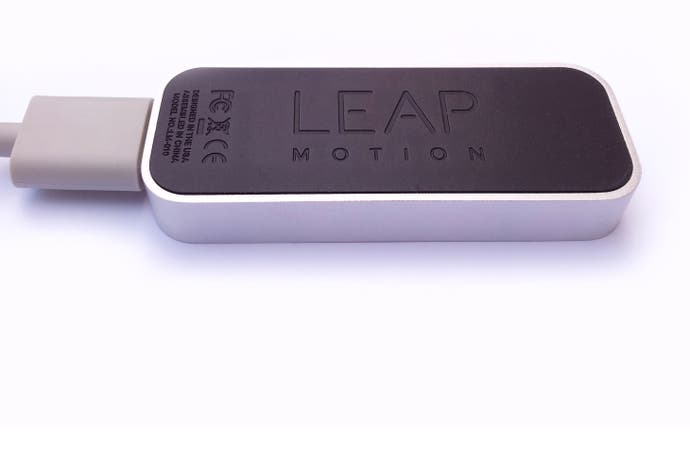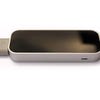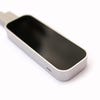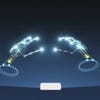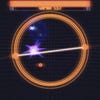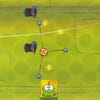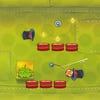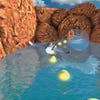Leap Motion review
The cutting edge in motion control?
With Microsoft's Kinect the popular standard for controller-free motion controls today, its reputation is on the negative side as far as core games are concerned, with even John Carmack dismissing it as a "zero-button mouse with a lot of latency." However, following multiple delays since its originally planned release in December last year, a new solution has entered the fray: the Leap Motion - a small USB-powered dongle that sits on your desk to interpret the subtlest of motions from all 10 digits. By promising to reduce input lag to imperceptible levels and offering the fine, granular level of control required to to play any type of game, could this £70 gizmo be capable of making motion controls a genuine alternative to a mouse for gaming and desktop use?
On paper the device sets itself far apart from Microsoft's offering, with Leaps Motion's CEO Michael Buckwald confidently declaring it to be "200 times more accurate than anything else on the market". This is perhaps an uneven comparison to make given the shortened radius of control compared to Kinect's living room focus, but for the purposes of gaming it speaks to the company's determination to ramp up accuracy in the place where it matters most: the hands. To make this all possible, the Leap Motion is equipped with two cameras and three infra-red LEDs that track anything within eight cubic feet above it, providing accurate feedback on each finger down to a claimed 0.01mm.
Unboxing the Leap controller, we're presented with two proprietary USB 2.0 cables and a small device that measures 80x30x10mm, curving at the edges with a silver bezel and a USB slot to one end. On top we have a glossy black panel beneath which all the sensors and cameras are positioned, while the back is rubberised to provide decent purchase on any desk. That's all we get in the package, with all the apps, drivers and updates being found on the company's browser-based Airspace store. Once plugged and activated, the device heats up noticeably as its three infra-red LEDs come alive at the centre, and a green power LED alights on the side.
The Airspace Home Launcher is needed before we can download any apps, allowing us to see our purchases from a clear grid-based menu. Calibration of the hardware is automatic once this is installed, and every time the PC is turned on it takes into account any ambient lights in the room, plus any dust or smudges that might need to be cleared. The tracking section in its control panel reveals some interesting metrics too, showing we're getting an average rate of 115 frames per second through the USB 2.0 interface - all delivered within an average processing time of 3.5 milliseconds with one hand raised. For two hands, that number ramps up to just 6ms in total, making for some awe-inspiringly speedy feedback once we get our first demo going.
"Leap Motion is equipped with two cameras and three infra-red LEDs that track anything within eight cubic feet above it, providing accurate feedback on each finger down to a claimed 0.01mm."
Leap Motion: a look at the software
Among the current selection of 75 apps available, most are either abstract tech demos, simplistic indie experiments or iPhone ports. There are no big names on the list here, unless you count Fruit Ninja as a major force in gaming, and the Half Life 2 mod shown in the device's original trailer is nowhere to be found by official means. Regardless, we boot up the Orientation app to kick things off, considered a starting point for demonstrating the underlying mechanics of its motion control.
Here, a skeletal map of each finger is shown as our digits move within the Leap Motion's cone of vision. Each ligament in our virtual fingers react with startling accuracy and speed compared to the real-life action, but the technology's shortcomings fall into clear sight within moments; specifically, if we hold our hands at any sort of angled incline, the tracking of most fingers flickers on and off erratically. This isn't a one-off issue either, as proven by the tech demo that follows - Flocking - which has each fingertip represented as a glowing light in the ocean. As we guide a company of low-poly fish around it proves very difficult indeed to keep all ten lights on-screen at once, making it an exercise in frustration when also factoring in the invisibility of the device's field of view.
With that in mind, the Leap Motion's ideal hand posture is a flattened one. Since the device only interprets from one spot on our desk rather than two at either side, it simply can't deal with hand formations in the shape of gun or lined vertically, as the little finger obscures the rest, leaving just a single light on-screen.
To lower the margin of error, the most effective uses of Leap Motion involve just one or two fingers, with desktop and web navigation taking that exact approach. The Touchless for Windows app allows us to operate our Windows 7 PC in a manner much like a tablet, with a pointer appearing on-screen to show where our single finger is hovering, while a jab forward represents a click. For scrolling? That'll be two fingers forward and drag. This style of control benefits hugely from the low latency response, and our finger never feels like it's being trailed by the on-screen dot. However, a PC is simply impractical to use in this state, with a click on a web link taking near-surgical accuracy as we slowly move our finger forward. Making sure to stay on target as we pass the clicking threshold is a challenge every time, and if it misses, we need to retreat the finger and hone-in slowly on that spot all over again.
"One of Leap's biggest drawbacks is the sensor's field of view - if we hold our hands at any sort of angled incline, the tracking of most fingers flickers on and off erratically."
Unfortunately, this official app doesn't support any games as found on Steam, but at a price there is a rock-solid alternative. A third-party app called GameWave is available for under a fiver, letting us play any shooter or racer to our liking by mapping swipes, points and multi-finger gestures to the typical keyboard and mouse inputs these games are expecting. If you've ever used a program like Xpadder you'll be familiar with the trial and error nature of the setup process here, where it's necessary to spend a good few minutes sorting out the bindings on a per-game basis. As a basic tool-set however, GameWave is hugely flexible if you're willing to put the time in, and it does a superb job of translating Leap Motion gestures to programs with zero native support.
Putting Portal 2 to the test with this program - being a relatively simple title in terms of first-person controls - it's clear our dream of going hands-only is out of reach though. In the best case scenario, we rely on our left hand for WASD movement controls, crouching, object interaction and jumps, while the right hand sweeps over the Leap Motion to aim the reticle. Camera controls are absolutely spot-on when sensitivity is reduced to 24 per cent while set to steering mode, with up, down, left and right motions linked to the according movements on a mouse. Setup is easier than it looks, and the deadband metre filters out any unwanted wobbles or shakes that hands naturally produce while hovering mid-air.
But the inevitable trip-up here is that gestures for actually firing your gun interfere with this crucial job of aiming, where setting a sideways tilt as your left trigger gesture, for example, causes the reticle to lurch every time you fire off a Portal. One decent alternative is using an open-hand gesture for this trigger, where spreading our fingers outwards would avoid any sudden camera jerks, with the trade-off being that this motion is sometimes ignored by the device due to its subtlety. When also considering the role of the right trigger and scroll wheel functions in most FPS games, it's quickly evident the keyboard side is going to have to pick up the slack for whichever configuration you design. In the end, translating motion controls to complex games built around the keyboard and mouse is a messy one, and outside of the novelty factor it offers no real advantage in accuracy.
"For first-person shooters, the inevitable trip-up with Leap Motion is that gestures for actually firing your gun interfere with the crucial job of aiming."
Games designed from the ground up to support this intricate level of motion control paint a different picture. For free, there's a clutch of exclusives to toy around with from the Airspace store, including 3D breakout clone Boom Ball and rhythm game Dropchord. The former is an absolute headache in every respect, but on paper the idea could have been interesting. Taking place within a cube, a single index finger controls the orientation of the player's shield to send the ball flying in different directions - though sensitivity is far too high and movements are too easily misread for this influence to be satisfying. To top it off, Boom Ball's physically demanding controls cause our arms wear out quickly - a trend noticed across several other games.
Arcade-style rhythm game Dropchord is, on the other hand, undoubtedly one of the more polished and enjoyable games on the store, and developer Double Fine has put plenty of thought into the ways to best harness the control system and avoid its pitfalls. The basics are easy to grasp: we raise two index fingers in order to guide two ends of a line over a circular field, the goal being to collect white dots at its centre while avoiding the hazardous red spots. Again, this high-energy game puts the biceps to work, giving us a dull ache in both arms after getting far enough to land a high score. And despite its best efforts we're still at the mercy of the technology's odd mishaps, where dust and changes in ambient lighting can cause the line to occasionally get stuck when we least expect it to. Nevertheless, when it works it's wonderfully addictive, and a perfect example of the form motion-based games could take in the future with refinement.
Solar Warfare is our next stop: a 3D aircraft shooter in the gameplay tradition of Star Fox 64, based on the Unity engine. Here we use a single flattened hand to determine the roll, pitch and yaw of the ship as we navigate through ravines and caves, bringing our fingers together in a cluster to fire the ship's lasers at oncoming enemies. Movement controls are generally well tuned and translate in a 1:1 fashion with our hand, while acceleration boosts are effectively mapped to sudden forward thrusts, with deceleration set to drawing the hand back towards the body.
Frustratingly, performing quick 180 degree turns is a necessity while flying around the game's many dust-bowl areas, which has us ricocheting off cavern walls very easily. Triggering laser-fire is also troublesome, with the Leap Motion sensors struggling to pick out our fingers when firmly stuck together, made all the harder for the device by their constant shifting about to control the ship's movements. These firing mechanics are simply too inconsistent for it to be relied upon once you have an enemy in your sights, and it hampers what could otherwise have been a very intuitive design.
"Right now, similar to Kinect, to get the most out of the device, developers need to target Leap Motion's strengths and work around its weaknesses."
Also based on the Unity engine is fantasy spell-dueller Runes, which amounts to a simple game of rock, paper, and scissors using the elements. The setup is turn-based, where both you and a druid opponent tee up as many elemental attacks as possible, all through brush-strokes, within a time limit to reduce the other's health bar to zero. When on the defensive, your job is to make the right gestures to counter the opponent's string of attacks with your own, and duels build up in complexity as your spell-book grows from the rudiments of fire, water and wind to a parchment of 15 spells. This puts your memory to the test more than anything - though occasional misreads from the Leap Motion are a factor when making even basic straight-line motions, which can frustrate.
For the sake of variety, we round off our motion-controlled gaming tour with Disney's racer, Wreck-it Ralph: Sugar Rush Speedway. This is is a crudely rendered 3D kart racer with garishly coloured dessert-themed stages and barebones driving mechanics; acceleration is automated, so we're simply left to steer by holding both hands up to grasp an invisible wheel. Ultimately, this approach is far more responsive than using the gyrometer in any iPad racer we've tried, but the implementation proves much too unreliable. More often than not, one hand loses sync with the device as it veers out of the Leap Motions' bounds, causing us to careen haplessly into an upcoming wall. It's frustrating to control, ugly and arm-ache inducing after 10 minutes, and worst of all we paid the best part of £2 for it.
To cleanse our palates we check out an educational program called Cyber Science 3D Motion, where the main goal (if you like) is to dissect a human skull. Selecting and moving each bone is achieved by sticking a thumb out to the side of your navigating hand, which once again introduces a new method for interacting with 3D elements and menus that doesn't translate to any other app. It's ineffective too, where dropping a selected skull piece by accident after selection happens regardless of whether the thumb is sticking out. The clumsy nature of controls here makes us curious to see if Leap Motion and Surgeon Simulator 2013 would be a match made in comedy heaven - we suspect it'd be better fit than any virtual game of Jenga could be, and certainly any attempt to solve a Rubik's cube in a hurry.
"The biggest deal-breaker for the technology right now is not its responsiveness but its consistency in picking up every motion."
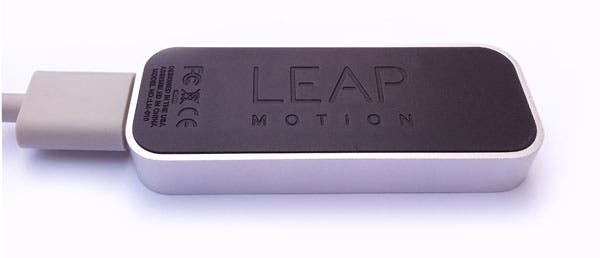
Leap Motion: the Digital Foundry verdict
Needless to say the latency-free, air-swiping promise of Leap Motion is enticing, but still needs work. The biggest deal-breaker for the technology right now is not its responsiveness but its consistency in picking up every motion. The device is in another league to Kinect in terms of detecting fine, sub-millimetre movements, but the drawback is that individual finger positions are still too easily misread during play. Certainly, we can manoeuvre and aim accurately with a single hand in games like Solar Warfare, but we can't trigger other actions with confidence by adding gestures on top of that.
The better games work around these restraints, such as Double Fine's decision to focus on using just two index fingers to guide a single line in Dropchord, which pays off in an infinitely more nuanced level of control. But even in cases where the experience is designed to keep this margin of error at at a minimum, the fact of the matter is that desktop browsing, plus games like Boom Ball, become too tiring to manage purely through motion controls for too long.
A lack of official support for gestures in existing shooters like Portal 2 is also a surprise, and makes manual gesture mapping via GameWave a necessary option that takes some work to achieve only mixed results. When it comes to more complex shooters like Battlefield 3, there's really still no convenient substitute for a mouse setup with two buttons and scroll-wheel, proving that native integration of motion controls is a must if it's ever to be achieved with an FPS. Demand for a motion-based shooter in this vein remains unanswered to this day on the Airspace store, so our eyes are on the upcoming Dead Motion Prologue to give us the first proper stab at it.
In all, if Kinect is by John Carmack's reckoning a laggy mouse with no click button, the Leap Motion is best described as a responsive mouse with a single, temperamental clicker. A long road lies ahead for this form of control, but the Leap Motion at least shows progress is being made; firmware updates keep rolling in and new apps are pending over and above the current 75 available. However, given that tracking all ten fingers with consistency is inherently difficult for the hardware, it's clear some ingenuity is needed from developers to draw Leap Motion's potential out of its shell. Much like how touch controls were in their infancy during the 90s and early 2000s before bursting out into mainstream use, it falls on app-makers to suss out the ideal workaround for Leap Motion's quirks, but in the here and now, we can't help but feel that the unit is a long way off being any kind of definitive motion control gaming device.
